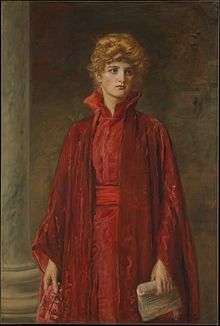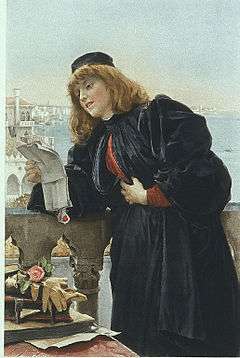Portia (''The Merchant of Venice'')
| Portia | |
|---|---|
| The Merchant of Venice character | |
 Kate Dolan as Portia, painted by John Everett Millais (1829–1896) | |
| Created by | William Shakespeare |
| Source | The Merchant of Venice |
Portia is the protagonist of William Shakespeare's The Merchant of Venice. A rich, beautiful, and intelligent heiress of Belmont, she is bound by the lottery set forth in her father's will, which gives potential suitors the chance to choose among three caskets. If he chooses the right casket, he wins Portia's hand in marriage. If he chooses the incorrect casket, he must leave and never seek another woman in marriage. She is said to be blonde and has curly hair. As Bassanio says to Antonio in (Act I scene I), she is more beautiful than the word itself. It is also seen that she is racist as she says that she will rather accept The Prince of Morocco as her religious adviser than her husband because of his dark complexion, which she refers as that of The Devil. She favours a young Venetian noble, soldier and a scholar, Bassanio. Later in the play, she disguises herself as a man, then assumes the role of a lawyer's apprentice (named Balthazar) whereby she saves the life of Bassanio's friend, Antonio, in court.
Portia is also fond of wordplay and proverbs, frequently quoting and coining them, which was considered a sign of wisdom and sharp wit in Elizabethan era. Some suggest that the character of Portia was based on queen Elizabeth herself, who also had a penchant for proverbs.[1][2]
Plot
Portia is one of the most prominent and appealing of the heroines in Shakespeare's mature romantic comedies. She is beautiful, gracious, rich, intelligent, and quick-witted, with high standards for her potential romantic partners. She obeys her father's will, while steadfastly seeking to obtain Bassanio.
She is bound by the lottery set forth in her father's will, which gives potential suitors the chance to choose between three caskets composed of gold, silver and lead. If they choose the right casket – the casket containing Portia's portrait and a scroll – they win her hand in marriage. If they choose the incorrect casket, they must leave and never seek another woman in marriage. Portia is glad when two suitors, one driven by greed and another by vanity, fail to choose correctly, although she demonstrates tact to the Princes of Morocco and Aragon, who unsuccessfully seek her hand. She favours Bassanio, a young Venetian noble, but is not allowed to give him any clues to assist in his choice.
Later in the play, she disguises herself as a man, then assumes the role of a lawyer's apprentice (named Balthazar) whereby she saves the life of Bassanio's friend, Antonio, in court.
In the court scenes, Portia finds a technicality in the bond, thereby outwitting Shylock and saving Antonio's life when everyone else including Antonio fails. It is Portia who delivers one of the most famous speeches in The Merchant of Venice:
The quality of mercy is not strain'd.
It droppeth as the gentle rain from heaven
Upon the place beneath. It is twice blest:
It blesseth him that gives and him that takes.
Despite Portia's lack of formal legal training, she wins her case by referring to the details of the exact language of the law. Her success involves prevailing on technicalities rather than the merits of the situation. She uses the tactics of what is sometimes called a Philadelphia lawyer. However, the concept of rhetoric and its abuse is also brought to light by Portia – highlighting the idea that an unjust argument may win through eloquence, loopholes and technicalities, regardless of the moral question at hand – and thus provoking the audience to consider that issue. After a few months, Portia and Bassanio live together along with Nerissa and her husband, and Antonio. Shylock has his job back, but only half his money, and Jessica and Lorenzo are found in Portia's castle.
Progenitor
The original Portia Shakespeare drew from was Porcia Catonis, the wife of the Roman statesman Brutus. She was also compared to the wife of Brutus within the play in Act 1 scene 1 when Bassanio talks to Antonio.
Portrayals
The strength of the role of Portia has made it attractive to many notable actresses. Frances Abington, Sarah Siddons and Elizabeth Whitlock all played Portia in the 18th century when actresses first started appearing on stage in performances of the play. More recently, the role has been depicted in the cinema and on television by a number of notable actresses such as Maggie Smith, Claire Bloom, Sybil Thorndike, Joan Plowright, Caroline John and Gemma Jones.


Cultural references
Aman The character of Portia has had a considerable and long-lived cultural impact.
- "Portia" is the name John Adams used to address his wife Abigail in his letters, presumably after Shakespeare's character. (Abigail addressed her husband as "Lysander" in letters a reference to a Shakespearean character appearing in A Midsummer Night's Dream.)
- The New England School of Law was originally known as the Portia Law School when it was established in 1908 as a women-only law school, and was known by that name until 1969.[3]
- In his Rumpole novels (filmed for the ITV series), author John Mortimer has Rumpole call Phyllida Erskine-Brown (née Trant) the "Portia of our Chambers".
- In 1986, a moon of Uranus was named after Portia (see Uranus' natural satellites).
- Portia de Rossi (born Amanda Lee Rogers), married to Ellen DeGeneres, adopted the name Portia to reinvent herself after becoming a model and actress.[4]
References
- ↑ Eva Lee Turner Clark (1974). Hidden allusions in Shakespeare's plays: a study of the early court revels and personalities of the times. Kennikat Press.
- ↑ Inge Leimberg (2011). 'What May Words Say . . . ?': A Reading of The Merchant of Venice. Fairleigh Dickinson.
- ↑ "Law School History". New England Law. Retrieved 19 August 2015.
- ↑ Kort, Michele (29 August 2005). "Portia heart & soul". The Advocate. Here Media. Archived from the original on 26 May 2015. Retrieved 19 August 2015.